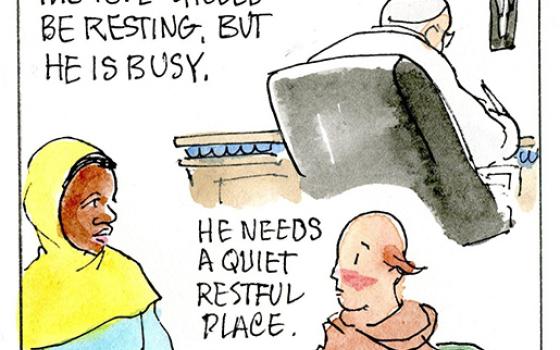The contrast, even to the casual observer of ecclesial politics, is startling.
In Boulder, Colo., last March, two girls, ages 5 and 3, were refused admittance to a Catholic elementary school after the pastor, Fr. William Breslin, and the elementary school principal found out that the children’s parents are a lesbian couple. Breslin contended, using some rather bizarre biblical proof-texting, that Jesus, too, turned people away.
Denver Archbishop Charles Chaput supported his pastor, explaining that “our schools are meant to be ‘partners in faith’ with parents,” and that if parents “don’t respect the beliefs of the church, or live in a manner that openly rejects those beliefs, then partnering with those parents becomes very difficult, if not impossible.” Chaput also said that children of same-sex couples would be unduly stressed in a Catholic environment where they’d have to sit through teaching of “the authentic faith of the church.”
Two months later, an 8-year-old boy was told his admittance to a Catholic school in the Boston archdiocese was revoked because his parents are a lesbian couple. The response in this case was quite different. The archdiocese immediately announced that it did not ban children of same-sex parents, who are duly informed that “the teachings of the church are an important component of the curriculum and are part of the students’ educational experience.”
Mary Grassa-O’Neill, secretary for education and superintendent of schools for the archdiocese, in consultation with Cardinal Sean O’Malley, said, “We believe that every parent who wishes to send their child to a Catholic school should have the opportunity to pursue that dream.”
The difference between the two situations is noteworthy for several reasons.
First, it allows Catholics to see that our leaders can have serious disagreements on how to handle difficult issues in the public realm. They can take very different “prudential” assessments of the same issue. It is good for the absolutists among us to recognize that fact.
Second, understanding the difference provides a peek into the church politics of the moment, for there is politics involved, and that is not meant in a disparaging sense. Politics is no more or less than a description of the reality. It is the same force at work when some bishops rush to the barricades to take on what they view as errant politicians and errant nuns and errant theologians, casting out harsh public judgment in their bid to protect the purity of what they deem is the only correct church position. Other bishops, we know, will have none of such confrontational tactics, opting instead for more textured and nuanced response to the endless range of complex issues with which the era confronts the religious community.
Finally, it is good to take note because underlying the differences are distinctly different approaches to church and how the mission of the church is projected into the wider culture. Is it a church that draws rigid boundaries and is mostly concerned with who’s in and who’s out and what rules the gatekeepers employ? Or is it a church more willing to leave final judgment to God and use mercy and compassion as the hallmarks of ministry?
In the end, the disagreements are good because they force the community, those of us in the lay state so often the concern of bishops who fuss and worry that we might be confused or scandalized, to consider issues from a number of points of view. Some might call that cafeteria Catholicism. It’s really just the work of pilgrims trying by their best lights to live out the Gospel. It is, as a poet once put it, living at the intersection of mysterious freedoms — God’s and our own. And resting secure in the knowledge that Jesus didn’t do ministry out of a code of canon law.
We shouldn’t have a problem admitting any children to our schools.



